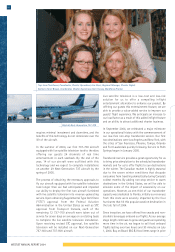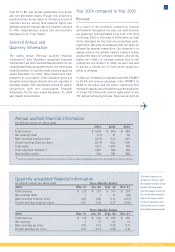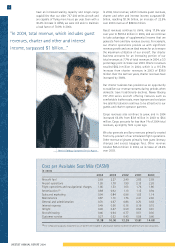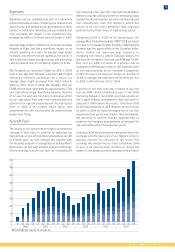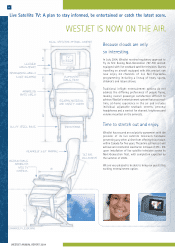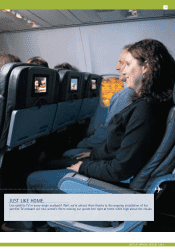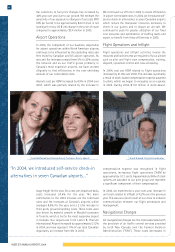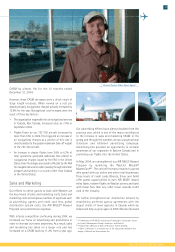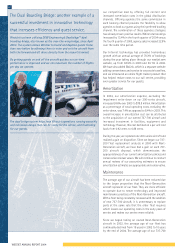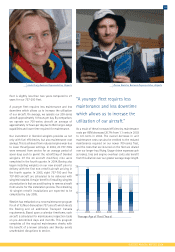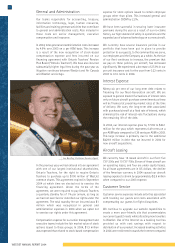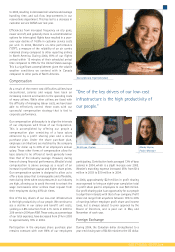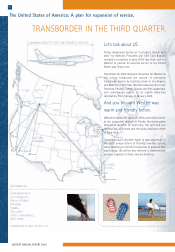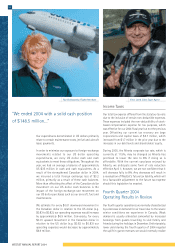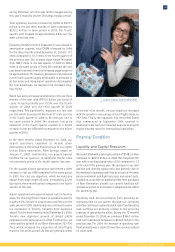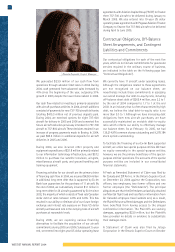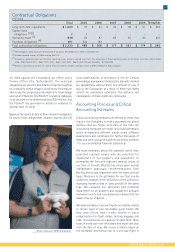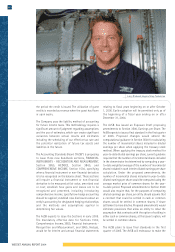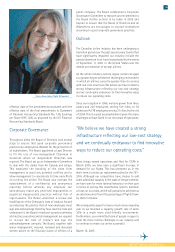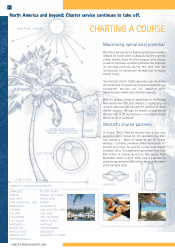Westjet 2004 Annual Report Download - page 30
Download and view the complete annual report
Please find page 30 of the 2004 Westjet annual report below. You can navigate through the pages in the report by either clicking on the pages listed below, or by using the keyword search tool below to find specific information within the annual report.
WESTJET ANNUAL REPORT 2004
30
General and Administration
Our teams responsible for accounting, treasury,
information technology, legal, human resources,
facilities and training generate activities that contribute
to general and administration costs. Also included in
these costs are senior management, executive
compensation and insurance.
In 2004, total general and administration costs increased
by 4.6% over 2003 on a per ASM basis. This increase
is a result of the new recognition of stock-based
compensation expense and fees incurred on our
financing agreement with Ontario Teachers' Pension
Plan Board (“Ontario Teachers”). We have also incurred
substantially higher legal fees during the past year as
litigation continues between WestJet and Air Canada
and WestJet and Jetsgo.
In the previous year, we had entered into an agreement
with one of our largest institutional shareholders,
Ontario Teachers, for the right to require Ontario
Teachers to purchase up to $100 million of WestJet
common shares. This agreement expired in September
2004 at which time we elected not to exercise the
financing agreement. Under the terms of the
agreement, we were required to pay Ontario Teachers
a quarterly standby fee of 1% per annum, as long as
we had not exercised or cancelled our rights under the
agreement. The total standby fee we incurred was $1
million which was recognized in general and
administration expenses in 2004 when we opted not
to exercise our rights under this agreement.
Compensation expense for our senior management and
executive teams include the fair market value of stock
options issued to these groups. In 2004, $1.3 million
was expensed that related to stock-based compensation
expense for stock options issued to certain employee
groups other than pilots. This increased general and
administration CASM by 2.2%.
We have been successful in securing lower insurance
premiums during the year as a result of our no-claims
history, our high standard of safety in operations and the
expanded use of advanced technology on our new aircraft.
We currently have several insurance policies in our
portfolio that have been put in place to provide
protection to our guests, to the communities we serve,
our employees and the Company as a whole. As the size
of our fleet continues to increase, the premium that
we pay on these policies, per aircraft, has decreased
significantly. We experienced a decrease of 27.3% in our
per unit insurance cost for the year from 0.22 cents in
2003 to 0.16 cents in 2004.
Interest Expense
Ninety-six per cent of our long-term debt relates to
financing for our Next-Generation aircraft. We are
exposed to general market fluctuations of interest rates
only on future aircraft purchase commitments as these
will be financed at prevailing market rates at the time
of delivery. We carry the long-term debt associated
with purchased aircraft at a fixed rate of interest, which
eliminates the risk of interest-rate fluctuations during
the remaining life of the debt.
In 2004, our interest expense grew by 77.0% to $44.1
million for the year, which represents 0.49 cents on a
per-ASM basis compared to 0.36 cents per ASM in 2003.
This large increase is primarily due to the additional
$429.9 million in debt that we incurred in 2004 for
new aircraft acquisitions.
Aircraft Leasing
We currently have 15 leased aircraft in our fleet: five
737-200s and 10 737-700s. Eleven of these aircraft are
on operating leases, and four are under capital leases.
As all lease agreements are in US dollars, the decline
of the American currency in 2004 caused our aircraft
leasing expense to shrink by approximately $2.9 million
when compared to our 2003 expense.
Customer Service
Customer service expenses include activities associated
with booking our guests and costs associated with
compensating our guests for flight disruptions.
We continue to upgrade our website capabilities to
create a more user-friendly site that accommodates
our current guests' needs while attracting new travellers
to WestJet. Use of the Internet as a booking tool has
provided us with cost savings with respect to
distribution of our product. Increased booking activities
in 2004 were redirected towards the Internet compared
Lee Bentley, Customer Service Agent


